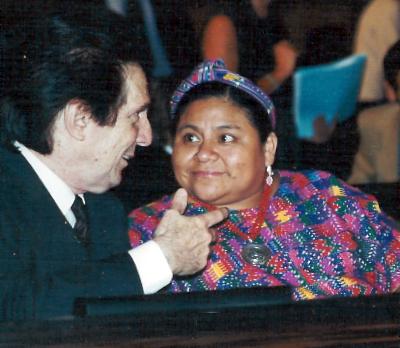Introduction and UNESCO's Mandate
Page 1
Yamousoukro and Seville Statement
Page 2
Origins and Executive Board Adoption
Pages 3 - 4
Launching the Programme: El Salvador and Roundtable
Pages 5 - 6 - 7
1993 General Conference
Page 8
National Projects
Pages 9 - 10
Programme Unit
Page 11
Toward a Global Scope
Pages 12 - 13
Transdisciplinary Project and Human Right to Peace
Pages 14 - 15 - 16
1997: A New Approach
Page 17
UN General Assembly Resolutions
Page 18
Resolution for International Year
Page 19
Declaration and Programme of Action
Pages 20 - 21
Resolution for International Decade
Pages 22 - 23
Training Programmes
Page 24
Global Movement
Pages 25 - 26
Publicity Campaign
Pages 27 - 28
Decentralized Network
Pages 29 - 30
Manifesto 2000
Page 31
Use of Internet
Pages 32 - 33
Future of the Culture of Peace
Pages 34 - 35 - 36 - 37 - 38
As described above, the International Decade for a Culture of Peace and Non-Violence for the Children of the World was originally the idea of Pierre Marchand and the Nobel Peace Laureates, linked at first to the project for the an International Year of Education for Nonviolence. Mr Marchand accepted the compromise to call for the Decade as a follow-up to an International Year for the culture of Peace, and he continued to lobby intensively for the proposal throughout 1997 and 1998 and to stay in contact with UNESCO. Along with Mr Rene Wadlow, also of "Partages", he met with the Director-General on 8 January 1998, and received the assurance, expressed in a letter of 26 February, of UNESCO support. Anticipating success for the Decade, Director-General began including reference to non-violence as well as peace in his speeches. At the United Nations, Ambassador Anwaral Chowdhury, having been successful in obtaining adoption of the International Year for the Culture of Peace and in calling for a Declaration and Programme of Action on a Culture of Peace, gave his support as well to an International Decade as a follow-up to the Year. A key question remained, however. What should the Decade be called?
The name of the Decade came into question at the ECOSOC meetings in New York in July 1998 where a resolution was proposed on 16 July by Ambassador Chowdhury entitled "International Decade for a Culture of Non-Violence and Peace for the Children of the World". Ms Sibal, in a letter dated 21 July to Ambassador Chowdhury, argued that it should be the "International Decade of Education for a Culture of Peace and Non-Violence". Although not stated, she felt that this would give UNESCO responsibility, whereas if the children were mentioned in the title, it would give UNICEF responsibility. In fact, at the urging of Ms Sibal, Director-General Mayor had already made the same suggestion to Mr Marchand in a letter dated July 1. The position of Sibal and Mayor was supported by the Latin American states during the informal discussions.
Eventually, the title of the Decade suggested by Mr Marchand was adopted as the "International Decade for a Culture of Non-Violence and Peace for the Children of the World" (see document of 28 July and ECOSOC debate described in memo of 30 July). Even then, however, some confusion remained. The official French version of the title puts non-violence before peace (similar to the original Chowdhury resolution), while the English version, which is the original, puts peace before non-violence in the title. And the matter of lead agency for the Decade was not resolved, the resolution mentioning both UNESCO and UNICEF, but without assigning responsibility. These matters were not resolved at the General Assembly debate on 10 November, where the ECOSOC version was adopted as resolution A/53/25. More attention was devoted at that point to the upcoming informals on the Declaration and Programme of Action on a Culture of Peace which faced resistance from Europe and the United States.

 |
 |
 |